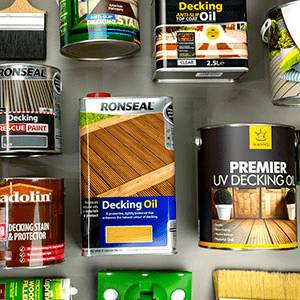Wood Stain FAQ's
What is a wood stain?
A wood stain is anything that changes the colour and appearance of wood. Although there are dedicated wood stain products, there are also many wood oils, waxes, varnishes and preservatives that both treat and colour interior and exterior wood.
What type of wood stain do I need?
The type of wood stain largely depends on the type of project and the type of finish required. For example, there are a huge range of stain colours, many that are 'wood tone' colours and others that are the primary colours. Wood stains are divided into those that require a top coat of varnish, oil or wax to seal in the colour, and those that are an all-in-one stain and sealer such as coloured waxes, varnishes and oils.
What is the difference between a wood stain and a wood dye?
In the context of pure wood stains and dyes, wood dyes are simply more concentrated than stains allowing them to be thinned if required or intermixed with compatible products to colour and tint them.
What is the benefit of a water-based stain?
Water-based stains are safe, low odour and very easy to apply. As they have very little smell, they're ideal for use on internal projects in confined spaces, such as for finishing wooden furniture and home crafts.
What is the benefit of a solvent-based stain?
Solvent-based wood stains are very quick drying, usually just 5 to 10 minutes. Unlike water-based stains that may raise the grain of the wood slightly, solvent-based stains do not, meaning a smoother surface and finish can be achieved. Solvent-based stains are also more compatible with high moisture environment such as kitchens and bathrooms.
I'm having trouble matching "Canadian Cedar" wood stains. Can you offer any advice?
When seeking a specific wood stain or dye colour, it's always better to search through colour swatches for a colour match rather than by a colour name. It's common for paints, stains and other coloured products to be given a name by the manufacturer which is their interpretation of the colour. The best way to show this is to do a Google image search for 'Medium Oak Wood' and see the multitude of colours all labelled as medium Oak.
Can I colour match different types of wood with a wood stain?
Colour matching different types of wood can be difficult especially if looking to achieve an exact match. This said, a close match can usually be achieved by using a wood stain. The important factor is to go by the colour of the product rather than by the colour name. For example, a medium oak stain from one manufacturer is likely to be different from a medium oak stain from any other. Another important factor to take into consideration is how the natural colouration of the timber influences any stain that is applied. For example, the same colour stain applied to pine, oak and beech will produce 3 different colours. The only way to work around this is to experiment with various stains and test areas on the wood to be stained. Most spirit and water-based stains such as Manns Classic Oak Stains for hardwoods, Manns Classic Pine Stain for softwoods can be thinned with water and intermixed to achieve virtually any colour or shade. See our full range of interior and exterior wood stains here.
What is the best top coat for a water-based stain on my bannister and balustrades?
Now you've gotten the colour just perfect to match the stairs, now it's time to protect it.
Wood oils are a fantastic option for the natural feel to the wood. They penetrate into the surface to protect against contact, scuffs, stains and minor scratches. Wood oils are very easy to maintain and repair and offer excellent coverage.
Another option is a wood varnish, the most durable type of wood finish. Varnishes effectively coat the wood with a tough, durable plastic coating. Highly recommended for banisters and balustrades which are subject to a high degree of contact.
Would I need to apply sanding sealer prior to staining the wood?
When staining wood, we recommend that the wood stain is applied directly to new bare wood or freshly sanded wood. Applying a sanding sealer would prevent the stain from penetrating in to the wood grain.
Do I need to put anything over a wood stain?
There are two types of wood stain. Most solvent or water-based stains just colour the wood. These stains need to be sealed in with a varnish, wax or oil. However, some products marketed as wood stains are all-in-one products that colour and protect / seal the wood. In the case of these products, there is no need to overcoat them with another product. If in doubt, always check the details on the back of the tin carefully before purchasing.
Can I use Manns Classic Pine Stain on woods other than pine?
Wood Stain related blog posts
- The Essential Guide to Wood Colour
- Decking Oil or Stain, Which is Best?
- How to Stain Wood - The Expert Guide
Disclaimer: Whilst every attempt has been made to provide product information that is as accurate as possible, it's important to clarify that trees and the wood that they produce can be affected by many factors. For example, the same species of tree grown in the same wood, even in close proximity, will be affected by age along with the amount of sunlight and water they receive. Other naturally occurring biological and environmental factors will also influence the density and grain of the wood as well as the moisture and oil content of the timber. No two trees are the same, meaning each piece of wood has the potential to look and react differently to the same wood finish. For example, product adhesion, colour variations, absorption rates and sheen levels. It is for this reason that we always strongly recommend carrying out test areas before starting any project


